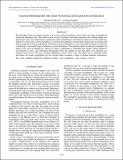| dc.contributor.author | Beatty, Thomas G. | |
| dc.contributor.author | Seager, Sara | |
| dc.date.accessioned | 2012-10-17T20:56:20Z | |
| dc.date.available | 2012-10-17T20:56:20Z | |
| dc.date.issued | 2010-03 | |
| dc.date.submitted | 2009-09 | |
| dc.identifier.issn | 0004-637X | |
| dc.identifier.issn | 1538-4357 | |
| dc.identifier.uri | http://hdl.handle.net/1721.1/74066 | |
| dc.description.abstract | The probability that an exoplanet transits its host star is high for planets in close orbits, but drops off rapidly for increasing semimajor axes. This makes transit surveys for planets with large semimajor axes orbiting bright stars impractical, since one would need to continuously observe hundreds of stars that are spread out over the entire sky. One way to make such a survey tractable is to constrain the inclination of the stellar rotation axes in advance, and thereby enhance the transit probabilities. We derive transit probabilities for stars with stellar inclination constraints, considering a reasonable range of planetary system inclinations. We find that stellar inclination constraints can improve the transit probability by almost an order of magnitude for habitable-zone planets. When applied to an ensemble of stars, such constraints dramatically lower the number of stars that need to be observed in a targeted transit survey. We also consider multiplanet systems where only one planet has an identified transit and derive the transit probabilities for the second planet assuming a range of mutual planetary inclinations. | en_US |
| dc.language.iso | en_US | |
| dc.publisher | IOP Publishing | en_US |
| dc.relation.isversionof | http://dx.doi.org/10.1088/0004-637x/712/2/1433 | en_US |
| dc.rights | Article is made available in accordance with the publisher's policy and may be subject to US copyright law. Please refer to the publisher's site for terms of use. | en_US |
| dc.source | IOP | en_US |
| dc.title | Transit Probabilities for Stars with Stellar Inclination Constraints | en_US |
| dc.type | Article | en_US |
| dc.identifier.citation | Beatty, Thomas G., and Sara Seager. “Transit Probabilities for Stars with Stellar Inclination Constraints.” The Astrophysical Journal 712.2 (2010): 1433–1442. © 2010 IOP Publishing | en_US |
| dc.contributor.department | Massachusetts Institute of Technology. Department of Earth, Atmospheric, and Planetary Sciences | en_US |
| dc.contributor.department | Massachusetts Institute of Technology. Department of Physics | en_US |
| dc.contributor.mitauthor | Seager, Sara | |
| dc.relation.journal | Astrophysical Journal | en_US |
| dc.eprint.version | Final published version | en_US |
| dc.type.uri | http://purl.org/eprint/type/JournalArticle | en_US |
| eprint.status | http://purl.org/eprint/status/PeerReviewed | en_US |
| dspace.orderedauthors | Beatty, Thomas G.; Seager, Sara | en |
| dc.identifier.orcid | https://orcid.org/0000-0002-6892-6948 | |
| mit.license | PUBLISHER_POLICY | en_US |
| mit.metadata.status | Complete | |
